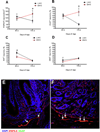Early life adversity in piglets induces long-term upregulation of the enteric cholinergic nervous system and heightened, sex-specific secretomotor neuron responses
- PMID: 27134125
- PMCID: PMC5002263
- DOI: 10.1111/nmo.12828
Early life adversity in piglets induces long-term upregulation of the enteric cholinergic nervous system and heightened, sex-specific secretomotor neuron responses
Abstract
Background: Early life adversity (ELA) is a risk factor for the later-life onset of gastrointestinal (GI) diseases such as irritable bowel syndrome (IBS); however, the mechanisms are poorly understood. Here, we utilized a porcine model of ELA, early weaning stress (EWS), to investigate the influence of ELA on the development and function of the enteric nervous system (ENS).
Methods: Female and castrated male (Male-C) piglets were weaned from their sow either at 15 days of age (EWS) or 28 days of age (late weaning control, LWC). At 60 and 170 days of age, ileal mucosa-submucosa preparations were mounted in Ussing chambers and veratridine- and corticotropin releasing factor (CRF)-releasing factor-evoked short circuit current (Isc ) responses were recorded as indices of secretomotor neuron function. Enteric neuron numbers and the expression of select neurotransmitters and their receptors were also measured.
Key results: Compared with LWC pigs, female, but not Male-C EWS, pigs exhibited heightened veratridine-induced Isc responses at 60 and 170 days of age that were inhibited with tetrodotoxin and atropine. Ileum from EWS pigs had higher numbers of enteric neurons that were choline acetyltransferase positive. Markers of increased cholinergic signaling (increased acetylcholinesterase) and downregulated mucosal muscarinic receptor 3 gene expression were also observed in EWS pigs.
Conclusions & inferences: This study demonstrated that EWS in pigs induces lasting and sex-specific hypersensitivity of secretomotor neuron function and upregulation of the cholinergic ENS. These findings may represent a mechanistic link between ELA and lifelong susceptibility to GI diseases such as IBS.
Keywords: cholinergic neurons; early life adversity; enteric nervous system development; irritable bowel syndrome; porcine model.
© 2016 John Wiley & Sons Ltd.
Conflict of interest statement
The authors declare no conflicts of interest.
Figures







References
-
- Talley NJ, Fett SL, Zinsmeister AR, Melton LJ., 3rd Gastrointestinal tract symptoms and self-reported abuse: a population-based study. Gastroenterology. 1994;107:1040–1049. - PubMed
-
- Drossman DA, Leserman J, Nachman G, et al. Sexual and physical abuse in women with functional or organic gastrointestinal disorders. Ann Intern Med. 1990;113:828–833. - PubMed
-
- Ercolani MFM, Agostini A, Baldoni F, Baracchini F, Ravegnani G, Bortolotti M. Gastroesophageal reflux diases (GERD) and inflammatory bowel disease (IBD): attachment styles and parental bonding. Perceptual and Motor Skills. 2010;111:625–630. - PubMed
-
- Agostini A, Rizzello F, Ravegnani G, et al. Adult attachment and early parental experiences in patients with Crohn's disease. Psychosomatics. 2010;51:208–215. - PubMed
MeSH terms
Grants and funding
LinkOut - more resources
Full Text Sources
Other Literature Sources
Medical

